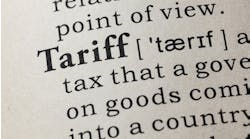Manufacturing activity grew “modestly” in September, the Federal Reserve reported today in its latest Beige Book survey, while overall economic activity continued to expand at a modest to moderate pace. This continued the same characterization of the economy by the bank for the past several months.
Manufacturing grew faster in Cleveland, St. Louis, and Minneapolis, the bank reported, while the New York, Richmond, and Chicago areas saw growth weaken.
"The period covered by the survey includes the weeks leading up to, as well as the first week of, the government shutdown," noted Andrew Labelle, a research associate with TD Economics. "The fact that the characterization of the economy remains unchanged is a positive signal, underscoring resilience in the face of government furloughs and declining consumer confidence."
The automotive and aerospace industries continued to be a source of manufacturing strength in much of the country, the Federal Reserve noted. Demand for fabricated metals was mixed in the Chicago and Richmond districts, but stronger in the Dallas district.
In the Philadelphia area, the bank noted that there was broadening optimism among manufacturers about business conditions for the next six months. “Contacts expect foreign and domestic demand to increase. Consequently, expectations of hiring and capital spending plans have largely rebounded since the last Beige Book, including more talk of "reshoring" of production that had gone overseas. However, several firms expect to deploy more capital than labor to meet higher production levels,” the report found.
The Cleveland, Chicago, St. Louis, and San Francisco districts reported steady increases in the demand for steel, the bank said, but added that much of the higher demand in Cleveland, Chicago, and Atlanta was being met by imports.
Demand for construction materials remained strong for Philadelphia, increased for Cleveland and San Francisco, was flat for Dallas, and was slightly lower for the Chicago area, the Federal Reserve stated. The Cleveland and Dallas areas reported strong demand for manufactured inputs to energy production, and demand for heavy equipment improved slightly in the Richmond and Chicago areas.
High-tech manufacturing activity edged up in a number of the bank’s districts, with Boston and Dallas reporting slightly higher demand for semiconductors, and biotech manufacturing increasing in San Francisco.
While there was little immediate disruption from the federal government shutdown, companies told the bank they were worried about the potential impact if the closing became prolonged.
National economic activity continued its expansion as eight districts reported similar growth rates as during the previous reporting period. Growth moderated in the Philadelphia, Richmond, Chicago, and Kansas City districts.
“Contacts across districts generally remained cautiously optimistic in their outlook for future economic activity, although many also noted an increase in uncertainty due largely to the federal government shutdown and debt ceiling debate,” the bank stated.
Consumer spending continued to increase, the Federal Reserve noted, and business spending and payrolls grew in many districts. Demand for nonfinancial services rose, and manufacturing activity also expanded modestly. Residential construction continued to increase at a moderate pace. By comparison, nonresidential construction again expanded at a slower rate.
Energy and mining activity expanded or maintained high levels, with the exception of the coal industry in the eastern half of the nation, the survey found. Price and wage pressures were again limited.



